Characteristics of Soil Organic Carbon (SOC) Loss with Water Erosion in Sloping Farmland of Southwestern China during Maize (Zea mays L.) Growth Stages
Abstract
1. Introduction
2. Materials and Methods
2.1. Experimental Site
2.2. Experimental Design
2.3. Runoff and Sediment Concentration
2.4. Determination of the Soil Organic Carbon
2.5. Statistical Analyses
3. Results
3.1. Changes in the Runoff Yield and Sediment Yield from Soil Erosion
3.1.1. Changes in the Runoff Yield
3.1.2. Changes in the Sediment Yield
3.2. Changes in the DOC Mass Concentration
3.2.1. Changes in the DOC Mass Concentration in Surface Runoff
3.2.2. Changes in the DOC Mass Concentration in Soil Interflow
3.3. Changes in the DOC Migration Flux
3.3.1. Changes in the DOC Migration Flux in the Surface Runoff
3.3.2. Changes in the DOC Migration Flux in Soil Interflow
3.4. Changes in SOC in Sediment
3.4.1. Changes in TOC Content in Sediment
3.4.2. Changes in the SOC Content in the Sediment Particle State
3.4.3. Changes in DOC Content in the Sediment
3.4.4. SOC Enrichment in Sediment
4. Discussion
4.1. Impacts of Different Erosion Stages on Runoff Yield, Sediment Yield and Carbon Loss
4.2. Impacts of Different Maize Growth Stages on Runoff Yield, Sediment Yield, and Carbon Loss
5. Conclusions
Author Contributions
Funding
Institutional Review Board Statement
Informed Consent Statement
Data Availability Statement
Acknowledgments
Conflicts of Interest
References
- Doetterl, S.; Berhe, A.A.; Nadeu, E.; Wang, Z.; Sommer, M.; Fiener, P. Erosion, deposition and soil carbon: A review of process-level controls, experimental tools and models to address C cycling in dynamic landscapes. Earth-Sci. Rev. 2016, 154, 102–122. [Google Scholar] [CrossRef]
- Houghton, R.A. Balancing the global carbon budget. Annu. Rev. Earth Planet. Sci. 2007, 35, 313–347. [Google Scholar] [CrossRef]
- Evans, C.D.; Monteith, D.T.; Cooper, D.M. Long-term increases in surface water dissolved organic carbon: Observations, possible causes and environmental impacts. Environ. Pollut. 2005, 137, 55–71. [Google Scholar] [CrossRef] [PubMed]
- Chappell, A.; Baldock, J.; Sanderman, J. The global significance of omitting soil erosion from soil organic carbon cycling schemes. Nat. Clim. Chang. 2016, 6, 187–191. [Google Scholar] [CrossRef]
- Deng, L.; Sun, T.; Fei, K.; Zhang, L.; Fan, X.; Wu, Y.; Ni, L. Effects of erosion degree, rainfall intensity and slope gradient on runoff and sediment yield for the bare soils from the weathered granite slopes of SE China. Geomorphology 2020, 352, 106997. [Google Scholar] [CrossRef]
- Fujii, K.; Uemura, M.; Hayakawa, C.; Funakawa, S.; Sukartiningsih, S.; Kosaki, T.; Ohta, S. Fluxes of dissolved organic carbon in two tropical forest ecosystems of East Kalimantan, Indonesia. Geoderma 2009, 152, 127–136. [Google Scholar] [CrossRef]
- Van Gaelen, N.; Verschoren, V.; Clymans, W.; Poesen, J.; Govers, G.; Vanderborght, J.; Diels, J. Controls on dissolved organic carbon export through surface runoff from loamy agricultural soils. Geoderma 2014, 226, 387–396. [Google Scholar] [CrossRef]
- Yang, Y.; Goldsmith, A.; Herold, I.; Lecha, S.; Toor, G.S. Assessing Soil Organic Carbon in Soils to Enhance and Track Future Carbon Stocks. Agronomy 2020, 10, 1139. [Google Scholar] [CrossRef]
- Doetterl, S.; van Oost, K.; Six, J. Towards constraining the magnitude of global agricultural sediment and soil organic carbon fluxes. Earth Surf. Process. Landf. 2012, 37, 642–655. [Google Scholar] [CrossRef]
- Pugach, S.P.; Pipko, I.I.; Semiletov, I.P.; Sergienko, V.I. Optical characteristics of the colored dissolved organic matter on the East Siberian shelf. Dokl. Earth Sci. 2015, 465, 1293–1296. [Google Scholar] [CrossRef]
- Van Gaelen, H.; Vanuytrecht, E.; Willems, P.; Diels, J.; Raes, D. Bridging rigorous assessment of water availability from field to catchment scale with a parsimonious agro-hydrological model. Environ. Model. Softw. 2017, 94, 140–156. [Google Scholar] [CrossRef]
- Oliveira, N.D.S.; Schiavo, J.A.; Pereira, M.G.; Coelho, R.D.S.; Ozorio, J.M.B.; de Moraes, E.M.V. Pedogenesis of soils with accumulation of organic carbon in the subsurface horizons in a saline lake in the Pantanal wetland of Nhecola circumflex accent ndia, Brazil. J. South Am. Earth Sci. 2022, 117, 103816. [Google Scholar] [CrossRef]
- Paula, R.R.; Calmon, M.; Lopes-Assad, M.L.; Mendonca, E.D.S. Soil organic carbon storage in forest restoration models and environmental conditions. J. For. Res. 2022, 33, 1123–1134. [Google Scholar] [CrossRef]
- Hoffmann, M.; Pohl, M.; Jurisch, N.; Prescher, A.K.; Campa, E.M.; Hagemann, U.; Remus, R.; Verch, G.; Sommer, M.; Augustin, J. Maize carbon dynamics are driven by soil erosion state and plant phenology rather than nitrogen fertilization form. Soil Tillage Res. 2018, 175, 255–266. [Google Scholar] [CrossRef]
- Ma, W.M.; Tang, S.H.; Dengzeng, Z.M.; Zhang, D.; Zhang, T.; Ma, X.L. Root exudates contribute to belowground ecosystem hotspots: A review. Front. Microbiol. 2022, 13, 937940. [Google Scholar] [CrossRef]
- Luo, J.; Zheng, Z.; Li, T.; He, S.; Wang, Y.; Zhang, X.; Huang, H.; Yu, H.; Liu, T. Characterization of runoff and sediment associated with rill erosion in sloping farmland during the maize-growing season based on rescaled range and wavelet analyses. Soil Tillage Res. 2019, 195, 104359. [Google Scholar] [CrossRef]
- Yang, C.; Su, Z.; Fan, J.; Fang, H.; Shi, L.; Zhang, J.; He, Z.; Zhou, T.; Wang, X. Simulation of the landform change process on a purple soil slope due to tillage erosion and water erosion using UAV technology. J. Mt. Sci. 2020, 17, 1333–1344. [Google Scholar] [CrossRef]
- Zheng, J.; He, X.; Walling, D.; Zhang, X.; Flanagan, D.; Qi, Y. Assessing soil erosion rates on manually-tilled hillslopes in the Sichuan Hilly Basin using Cs-137 and Pb-210(ex) measurements. Pedosphere 2007, 17, 273–283. [Google Scholar] [CrossRef]
- Zhao, L.; Jin, J.; Du, S.; Liu, G. A Quantification of the Effects of Erosion on the Productivity of Purple Soils. J. Mt. Sci. 2012, 9, 96–104. [Google Scholar] [CrossRef]
- Zhong, S.; Han, Z.; Duo, J.; Ci, E.; Ni, J.; Xie, D.; Wei, C. Relationships between the lithology of purple rocks and the pedogenesis of purple soils in the Sichuan Basin, China. Sci. Rep. 2019, 9, 13272. [Google Scholar] [CrossRef]
- Dai, J.; Zhang, J.; Zhang, Z.; Jia, L.; Xu, H.; Wang, Y. Effects of water discharge rate and slope gradient on runoff and sediment yield related to tillage erosion. Arch. Agron. Soil Sci. 2021, 67, 849–861. [Google Scholar] [CrossRef]
- Su, Z.; Zhang, J.; Xiong, D.; Liu, G. Assessment of Soil Erosion by Compensatory Hoeing Tillage in a Purple Soil. J. Mt. Sci. 2012, 9, 59–66. [Google Scholar] [CrossRef]
- Dai, J.; Zhang, J.; Xue, K.; Yang, F.; Huang, F.; Zhao, H.; Ma, X.; Dai, C.; Xu, Y.; Li, M.; et al. Effects of spatial variations in rock fragments related to tillage on hydrological processes and sediment transport. Catena 2022, 211, 105963. [Google Scholar] [CrossRef]
- Zhao, Q.; Li, D.; Zhuo, M.; Guo, T.; Liao, Y.; Xie, Z. Effects of rainfall intensity and slope gradient on erosion characteristics of the red soil slope. Stoch. Environ. Res. Risk Assess. 2015, 29, 609–621. [Google Scholar] [CrossRef]
- Jiang, F.; Zhan, Z.; Chen, J.; Lin, J.; Wang, M.K.; Ge, H.; Huang, Y. Rill erosion processes on a steep colluvial deposit slope under heavy rainfall in flume experiments with artificial rain. Catena 2018, 169, 46–58. [Google Scholar] [CrossRef]
- Jiang, Y.; Shi, H.; Wen, Z.; Guo, M.; Zhao, J.; Cao, X.; Fan, Y.; Zheng, C. The dynamic process of slope rill erosion analyzed with a digital close range photogrammetry observation system under laboratory conditions. Geomorphology 2020, 350, 106893. [Google Scholar] [CrossRef]
- Hua, K.; Zhu, B.; Wang, X.; Tian, L. Forms and Fluxes of Soil Organic Carbon Transport via Overland Flow, Interflow, and Soil Erosion. Soil Sci. Soc. Am. J. 2016, 80, 1011–1019. [Google Scholar] [CrossRef]
- Lal, R. Soil erosion and the global carbon budget. Environ. Int. 2003, 29, 437–450. [Google Scholar] [CrossRef]
- Xu, H.; Zhang, J.; Wei, Y.; Dai, J.; Wang, Y. Bedrock erosion due to hoeing as tillage technique in a hilly agricultural landscape, southwest China. Earth Surf. Process. Landf. 2020, 45, 1418–1429. [Google Scholar] [CrossRef]
- Lovelock, C.E.; Feller, I.C.; Ellis, J.; Schwarz, A.M.; Hancock, N.; Nichols, P.; Sorrell, B. Mangrove growth in New Zealand estuaries: The role of nutrient enrichment at sites with contrasting rates of sedimentation. Oecologia 2007, 153, 633–641. [Google Scholar] [CrossRef]
- Carr, T.W.; Balkovic, J.; Dodds, P.E.; Folberth, C.; Fulajtar, E.; Skalsky, R. Uncertainties, sensitivities and robustness of simulated water erosion in an EPIC-based global gridded crop model. Biogeosciences 2020, 17, 5263–5283. [Google Scholar] [CrossRef]
- Zhou, T.; Su, Z.; He, Z.; Zhang, X.; Wang, X.; Wang, J.; Liu, Y.; Wu, Z.; Wang, L. Simulation of the impacts of native vegetation and polyacrylamide on hydraulic properties and heavy metal concentrations at mine dumps. Land Degrad. Dev. 2021, 32, 2749–2761. [Google Scholar] [CrossRef]
- Wang, Y.; Zhang, J.H.; Zhang, Z.H. Influences of intensive tillage on water-stable aggregate distribution on a steep hillslope. Soil Tillage Res. 2015, 151, 82–92. [Google Scholar] [CrossRef]
- Dusek, J.; Dohnal, M.; Vogel, T.; Marx, A.; Barth, J.A.C. Modelling multiseasonal preferential transport of dissolved organic carbon in a shallow forest soil: Equilibrium versus kinetic sorption. Hydrol. Process. 2019, 33, 2898–2917. [Google Scholar] [CrossRef]
- Cao, L.; Zhang, Y.; Lu, H.; Yuan, J.; Zhu, Y.; Liang, Y. Grass hedge effects on controlling soil loss from concentrated flow: A case study in the red soil region of China. Soil Tillage Res. 2015, 148, 97–105. [Google Scholar] [CrossRef]
- Li, M.; Wang, J.; Guo, D.; Yang, R.; Fu, H. Effect of land management practices on the concentration of dissolved organic matter in soil: A meta-analysis. Geoderma 2019, 344, 74–81. [Google Scholar] [CrossRef]
- Hua, K.; Zhu, B.; Wang, X. Dissolved organic carbon loss fluxes through runoff and sediment on sloping upland of purple soil in the Sichuan Basin. Nutr. Cycl. Agroecosyst. 2014, 98, 125–135. [Google Scholar] [CrossRef]
- Jost, G.; Schume, H.; Hager, H.; Markart, G.; Kohl, B. A hillslope scale comparison of tree species influence on soil moisture dynamics and runoff processes during intense rainfall. J. Hydrol. 2012, 420, 112–124. [Google Scholar] [CrossRef]
- Xia, L.; Song, X.; Fu, N.; Cui, S.; Li, L.; Li, H.; Li, Y. Effects of rock fragment cover on hydrological processes under rainfall simulation in a semi-arid region of China. Hydrol. Process. 2018, 32, 792–804. [Google Scholar] [CrossRef]
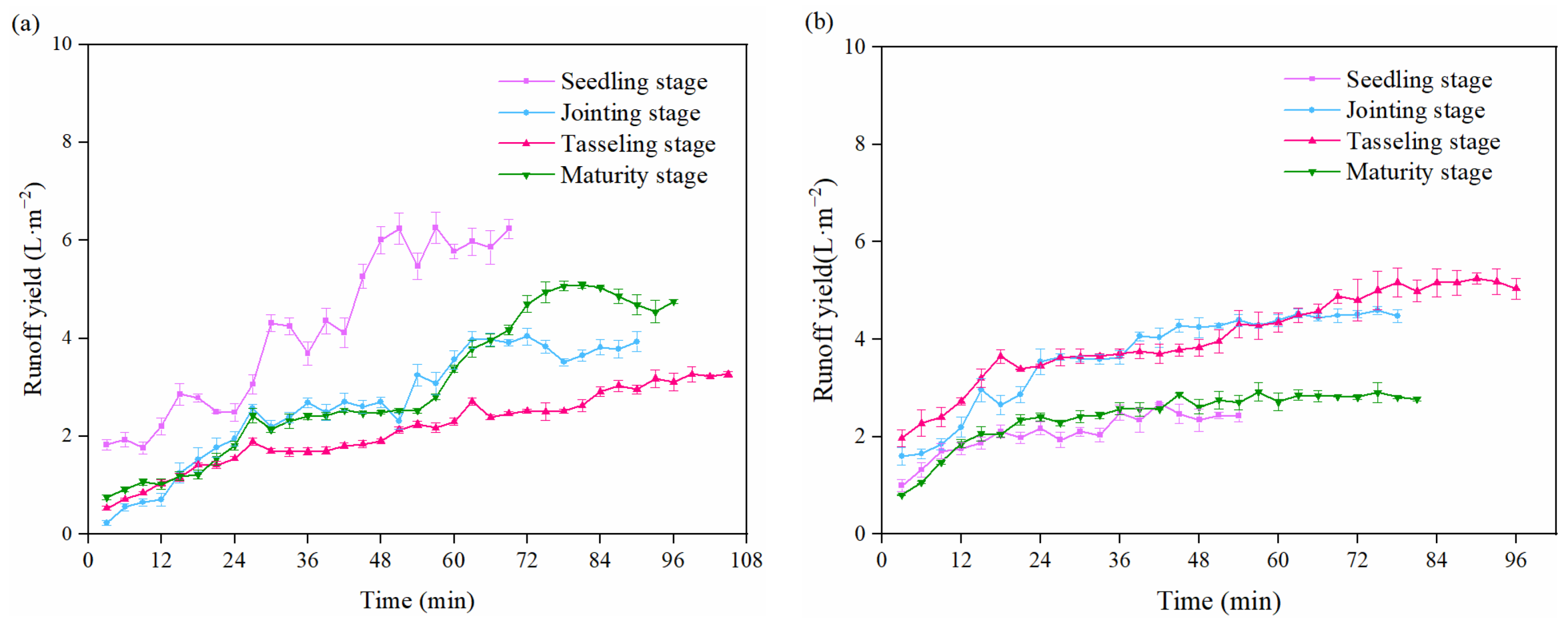

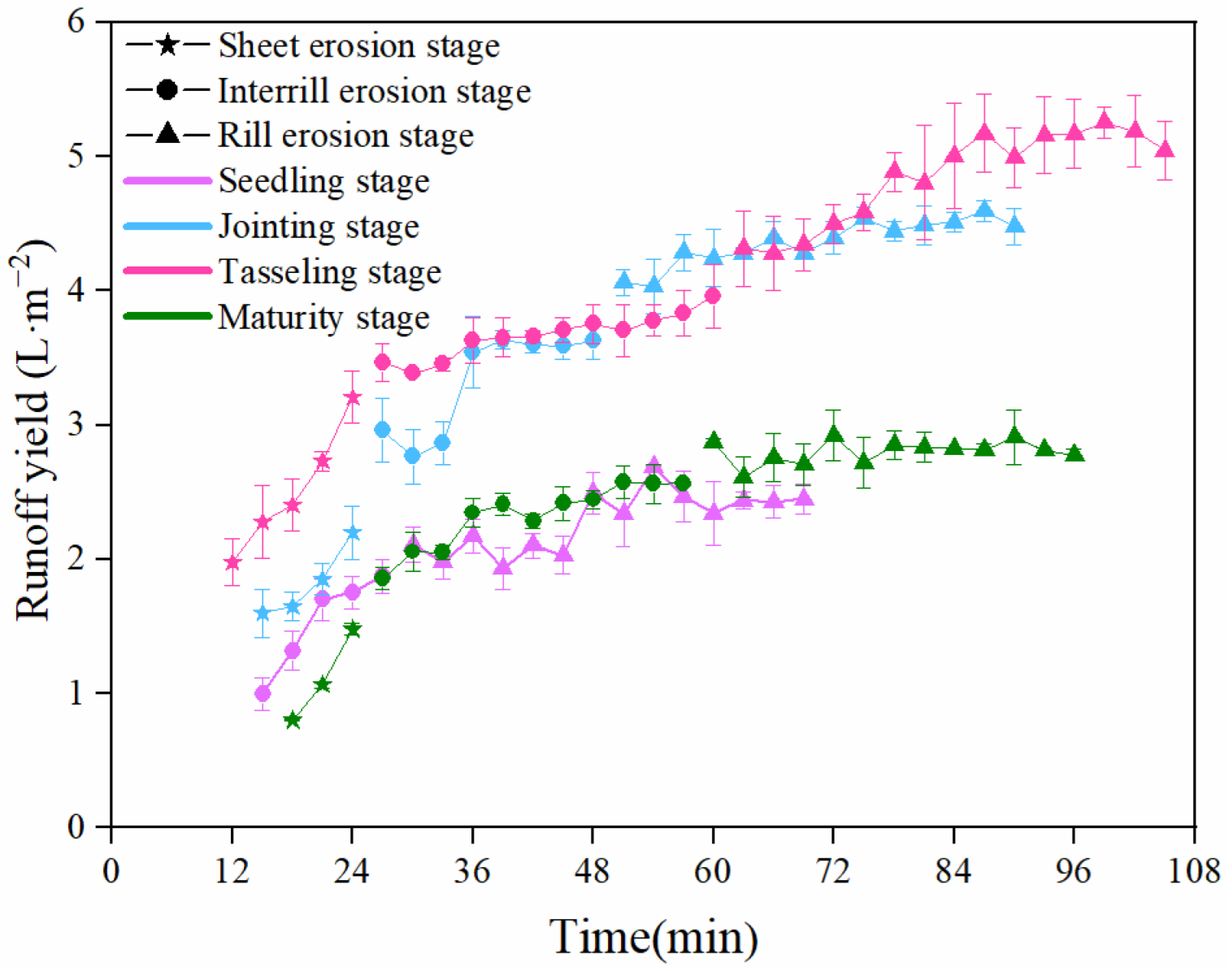
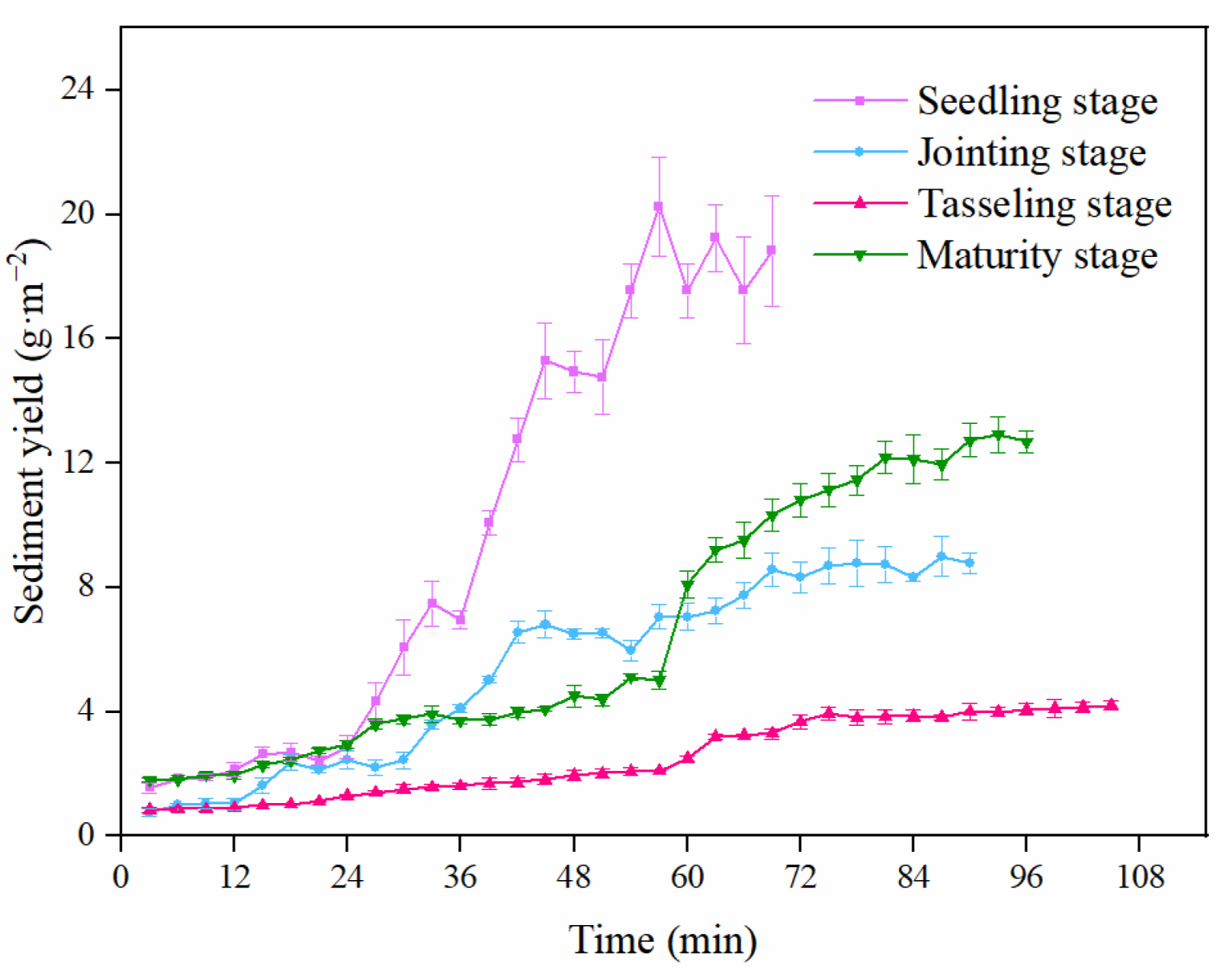
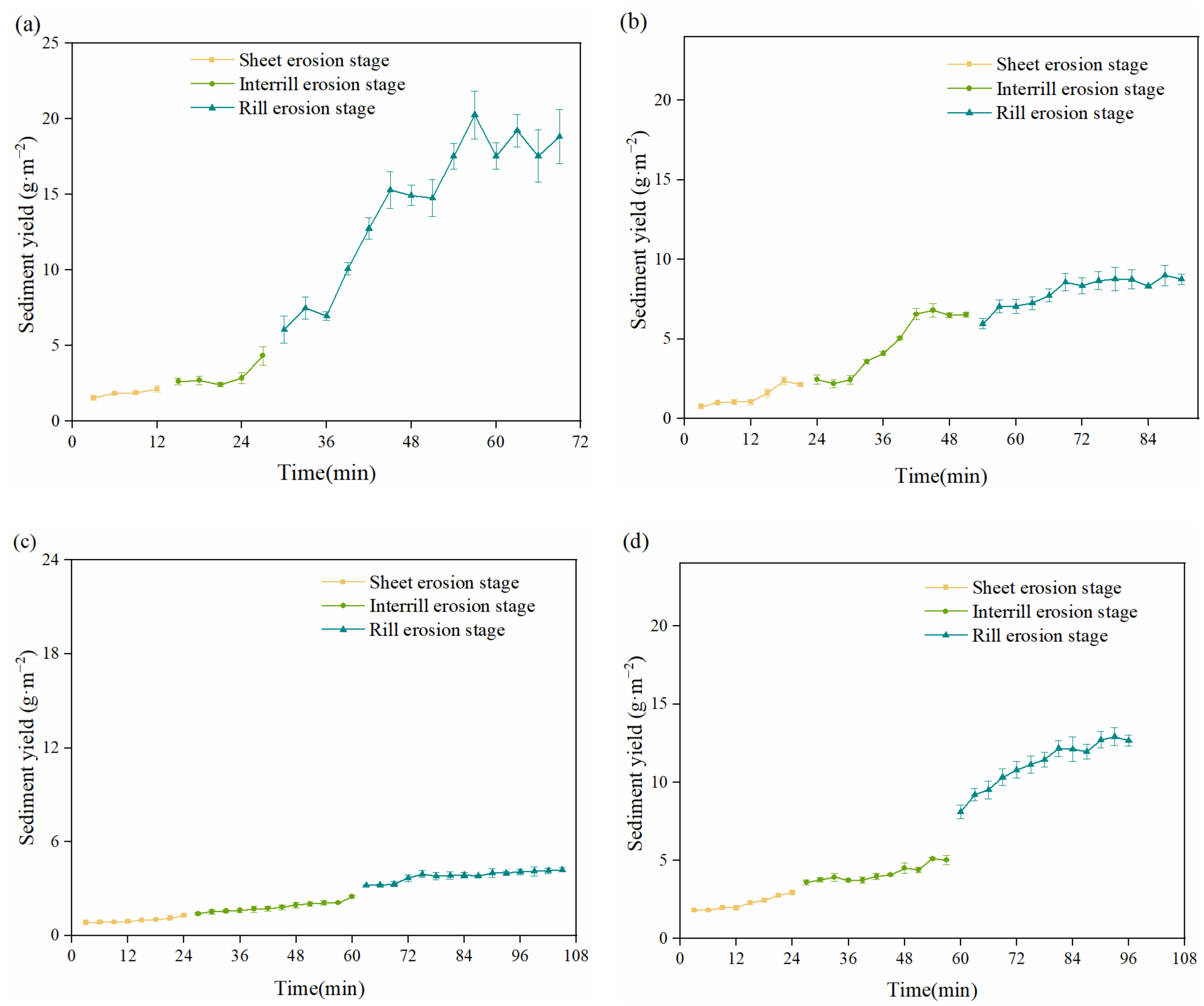
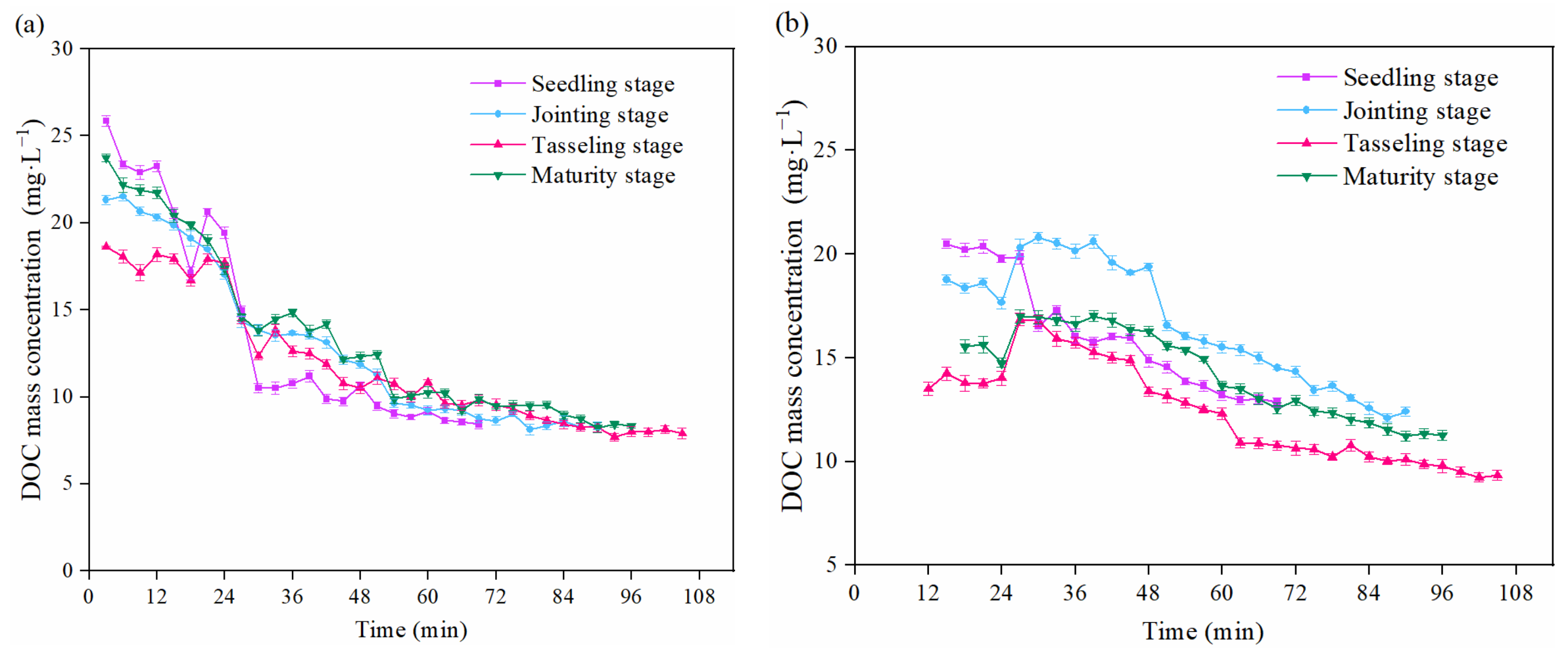
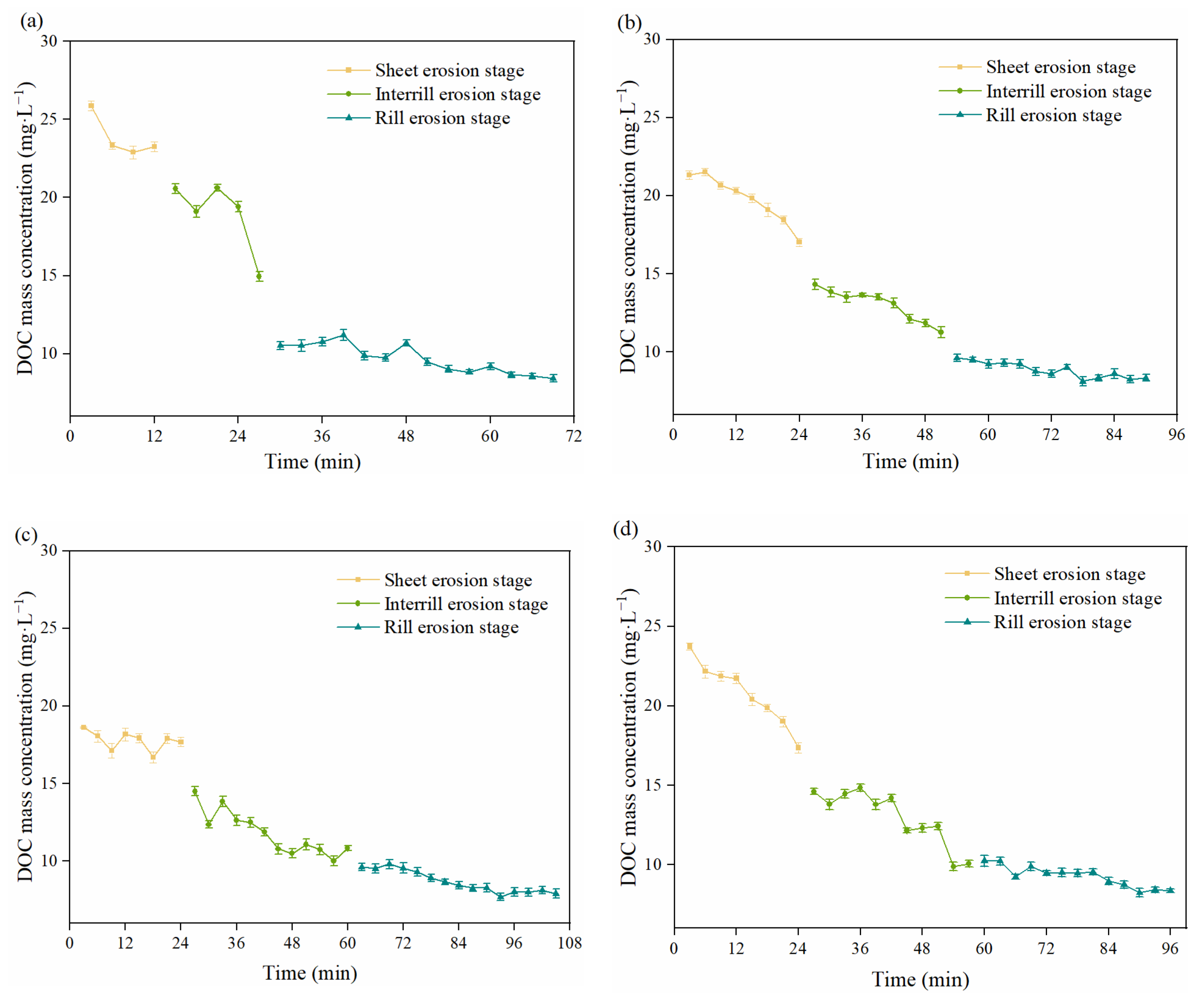

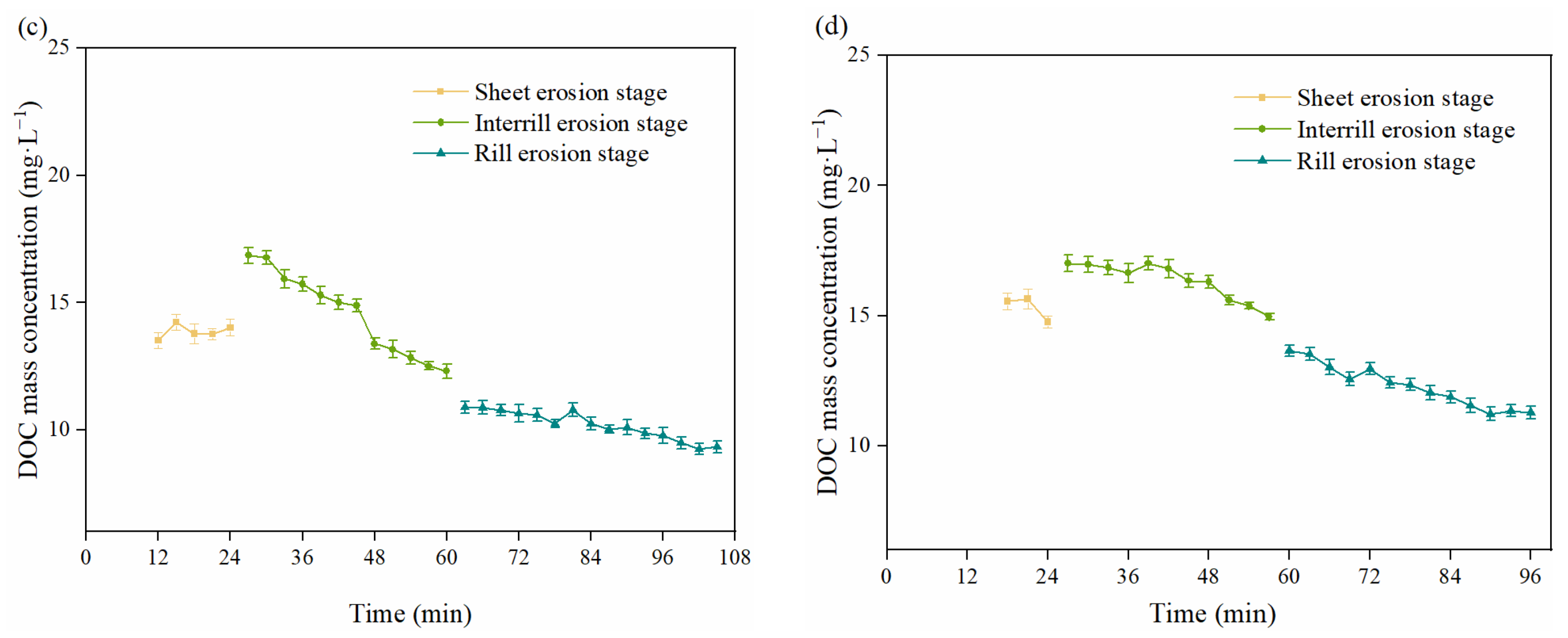
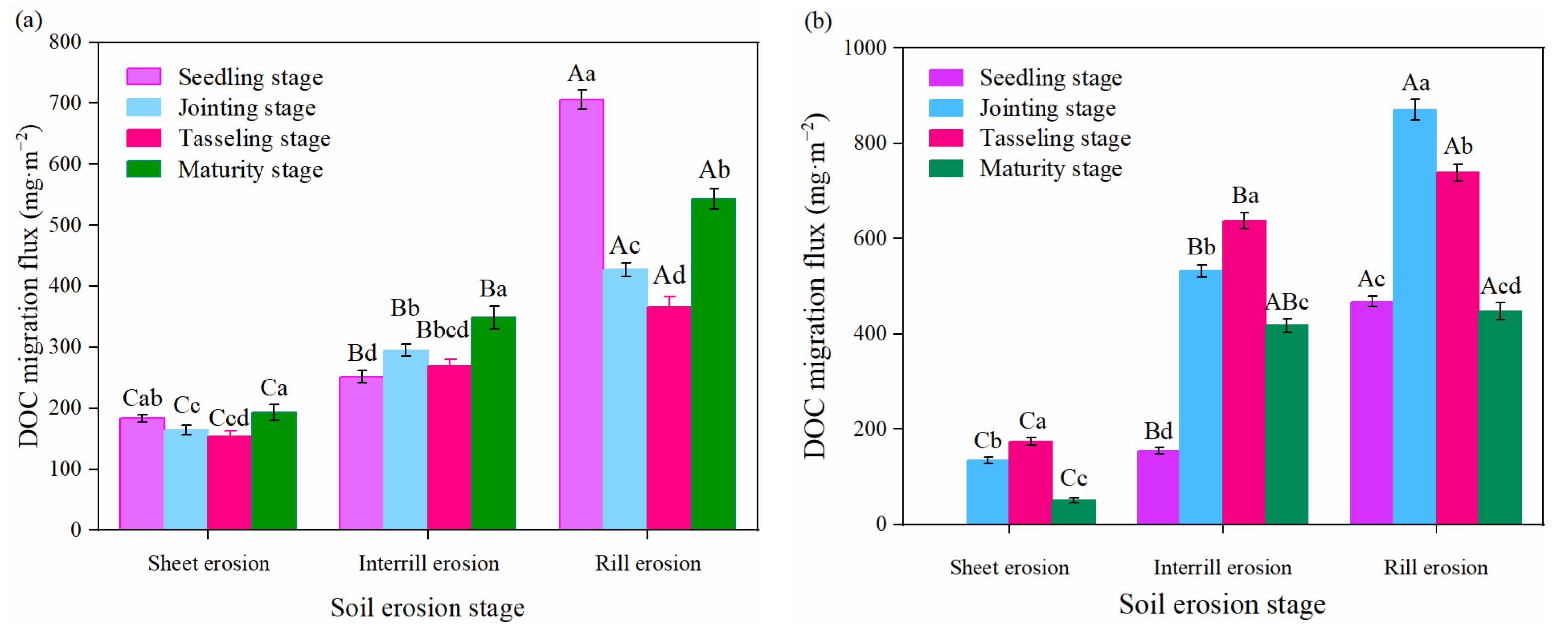
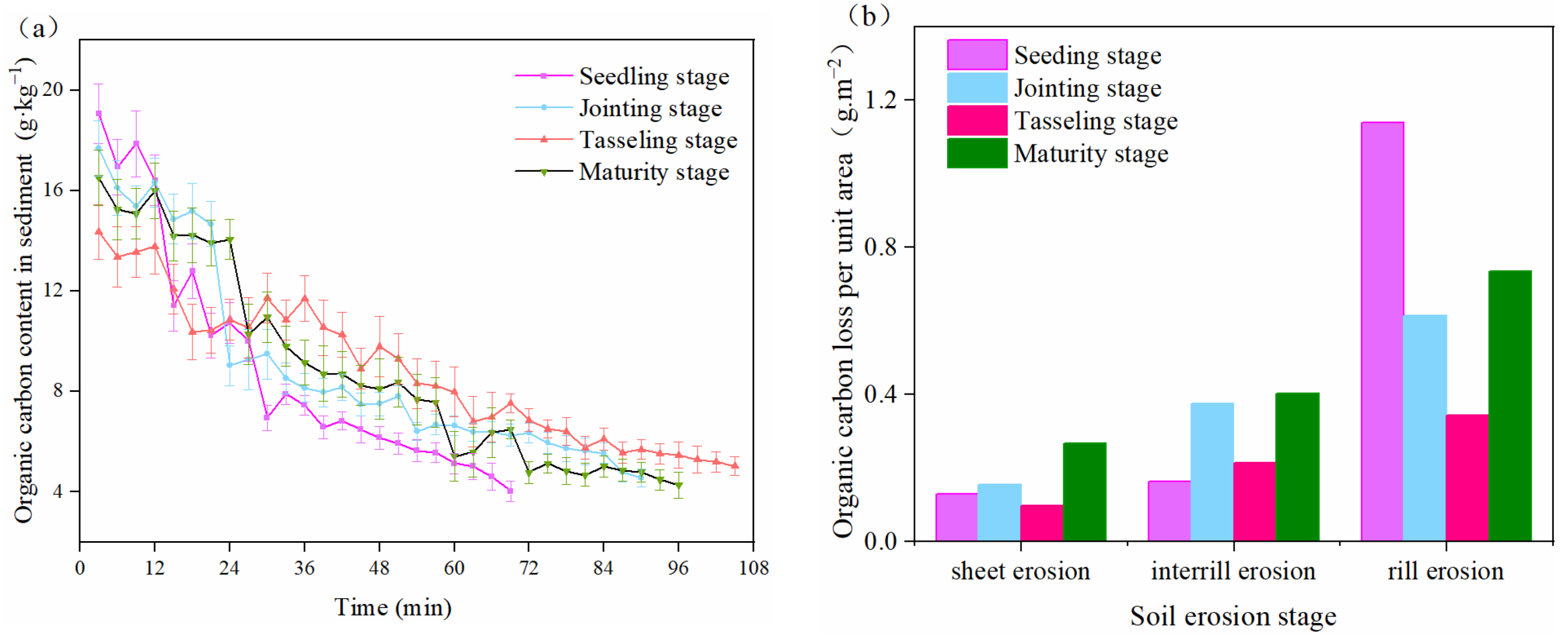

| Soil Erosion Stages | Mass Fraction of Sediment Particles (%) | |||
|---|---|---|---|---|
| Seedling Stage | Jointing Stage | Tasseling Stage | Maturity Stage | |
| Sheet erosion | 7.98 C ± 0.02 | 6.48 C ± 0.01 | 6.37 B ± 0.01 | 6.92 C ± 0.03 |
| Interrill erosion | 10.47 B ± 0.03 | 9.5 B ± 0.04 | 8.14 AB ± 0.01 | 9.98 B ± 0.03 |
| Rill erosion | 12.1 A ± 0.02 | 10.67 A ± 0.01 | 9.52 A ± 0.01 | 11.68 A ± 0.02 |
| Soil Erosion Stages | Organic Carbon Content of Sediment Particles (g·kg−1) | |||
|---|---|---|---|---|
| Seedling Stage | Jointing Stage | Tasseling Stage | Maturity Stage | |
| Sheet erosion | 1.87 a ± 0.09 | 1.22 cd ± 0.16 | 1.17 bcd ± 0.19 | 1.59 ad ± 0.50 |
| Interrill erosion | 1.56 ac ± 0.49 | 1.18 acd ± 0.46 | 1.00 bd ± 0.07 | 1.22 acd ± 0.30 |
| Rill erosion | 1.32 ac ± 0.21 | 1.02 acd ± 0.13 | 0.90 bd ± 0.09 | 1.21 acd ± 0.50 |
| Soil Erosion Stages | DOC Concentration (g·kg−1) | |||
|---|---|---|---|---|
| Seedling Stage | Jointing Stage | Tasseling Stage | Maturity Stage | |
| Sheet erosion | 1.04 A ± 0.11 | 1.47 A ± 0.28 | 0.97 A ± 0.12 | 0.83 A ± 0.06 |
| Interrill erosion | 0.74 B ± 0.05 | 0.81 B ± 0.24 | 0.85 B ± 0.08 | 0.76 AB ± 0.15 |
| Rill erosion | 0.72 BC ± 0.08 | 0.65 BC ± 0.09 | 0.81 BC ± 0.04 | 0.51 C ± 0.05 |
| Soil Erosion Stages | SOC Enrichment Ratio | |||
|---|---|---|---|---|
| Seedling Stage | Jointing Stage | Tasseling Stage | Maturity Stage | |
| Sheet erosion | 3.00 | 2.90 | 2.56 | 2.92 |
| Interrill erosion | 1.88 | 1.66 | 1.68 | 1.96 |
| Rill erosion | 1.03 | 1.10 | 1.05 | 1.21 |
Disclaimer/Publisher’s Note: The statements, opinions and data contained in all publications are solely those of the individual author(s) and contributor(s) and not of MDPI and/or the editor(s). MDPI and/or the editor(s) disclaim responsibility for any injury to people or property resulting from any ideas, methods, instructions or products referred to in the content. |
© 2023 by the authors. Licensee MDPI, Basel, Switzerland. This article is an open access article distributed under the terms and conditions of the Creative Commons Attribution (CC BY) license (https://creativecommons.org/licenses/by/4.0/).
Share and Cite
He, Z.; Xu, H.; He, S.; Liang, X.; Zheng, Z.; Luo, Z.; Wang, Y.; Zhang, Y.; Tan, B. Characteristics of Soil Organic Carbon (SOC) Loss with Water Erosion in Sloping Farmland of Southwestern China during Maize (Zea mays L.) Growth Stages. Agronomy 2023, 13, 738. https://doi.org/10.3390/agronomy13030738
He Z, Xu H, He S, Liang X, Zheng Z, Luo Z, Wang Y, Zhang Y, Tan B. Characteristics of Soil Organic Carbon (SOC) Loss with Water Erosion in Sloping Farmland of Southwestern China during Maize (Zea mays L.) Growth Stages. Agronomy. 2023; 13(3):738. https://doi.org/10.3390/agronomy13030738
Chicago/Turabian StyleHe, Zhouyao, Hang Xu, Shuqin He, Xinlan Liang, Zicheng Zheng, Ziteng Luo, Yong Wang, Yunqi Zhang, and Bo Tan. 2023. "Characteristics of Soil Organic Carbon (SOC) Loss with Water Erosion in Sloping Farmland of Southwestern China during Maize (Zea mays L.) Growth Stages" Agronomy 13, no. 3: 738. https://doi.org/10.3390/agronomy13030738
APA StyleHe, Z., Xu, H., He, S., Liang, X., Zheng, Z., Luo, Z., Wang, Y., Zhang, Y., & Tan, B. (2023). Characteristics of Soil Organic Carbon (SOC) Loss with Water Erosion in Sloping Farmland of Southwestern China during Maize (Zea mays L.) Growth Stages. Agronomy, 13(3), 738. https://doi.org/10.3390/agronomy13030738









